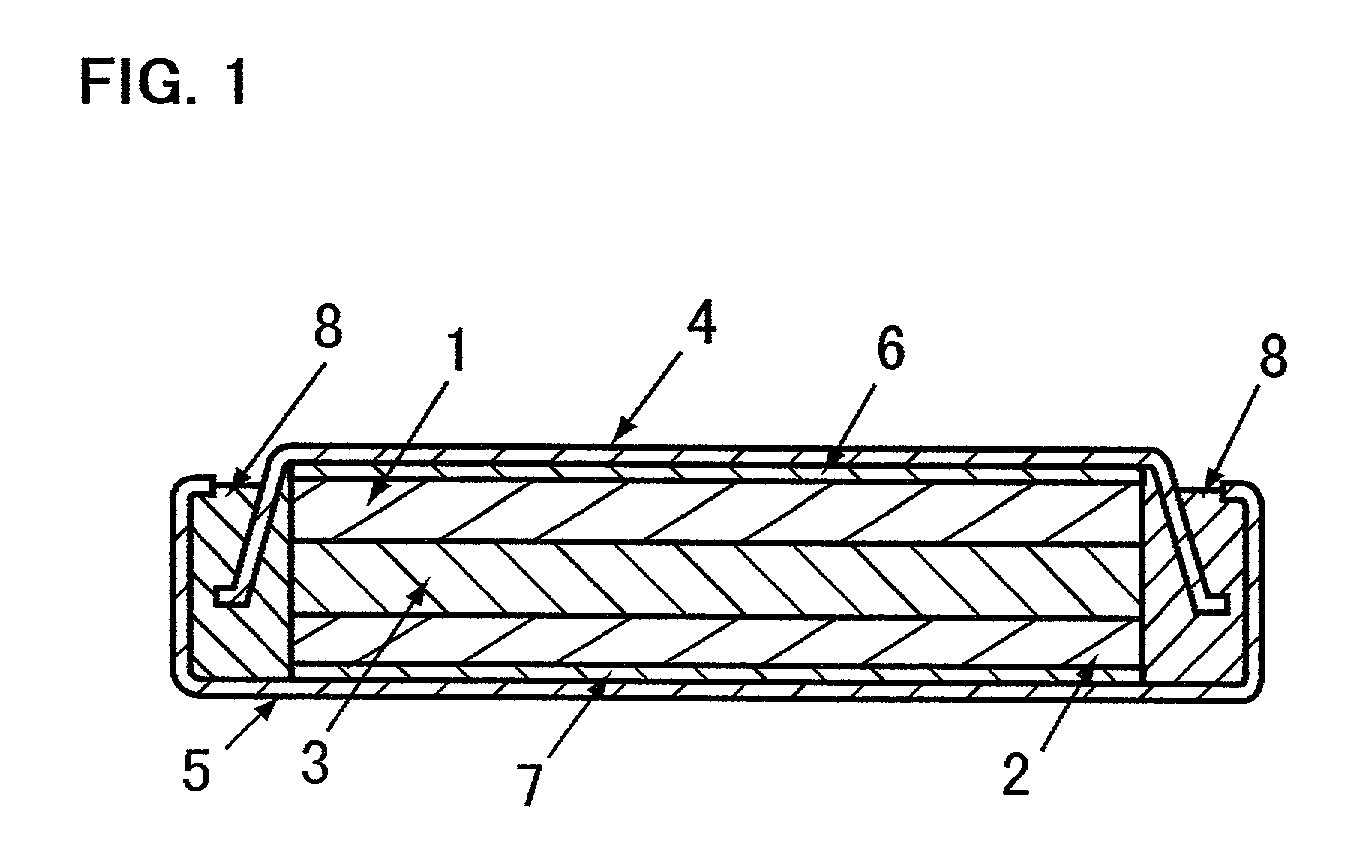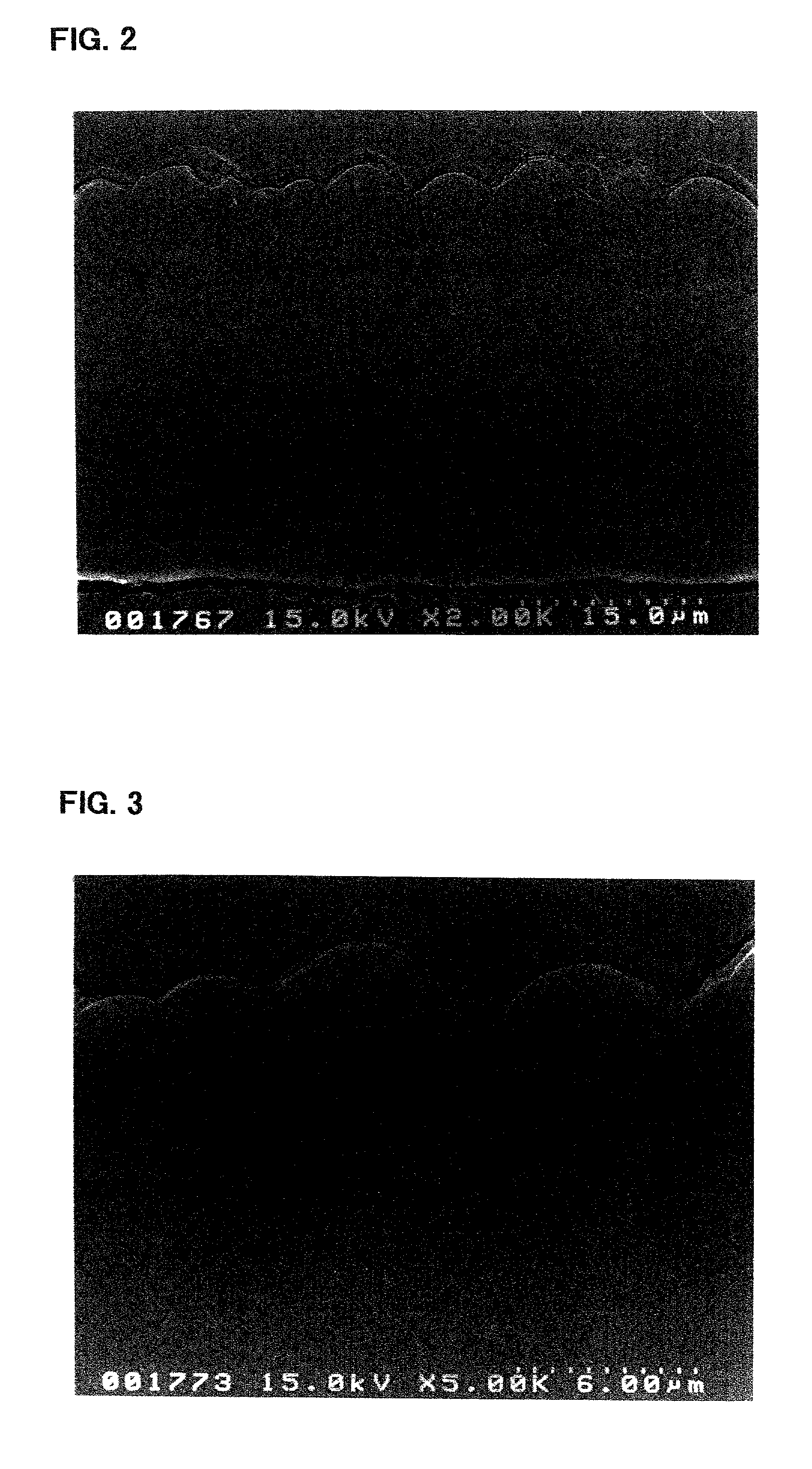Electrode for use in lithium battery and rechargeable lithium battery
a lithium battery and electrode technology, applied in secondary cells, electrochemical generators, cell components, etc., can solve the problems of short circuiting in the internal cavity, alloying negative electrodes failing to provide sufficient cycle characteristics, etc., and achieve excellent charge-discharge cycle characteristics and high charge-discharge capacity
- Summary
- Abstract
- Description
- Claims
- Application Information
AI Technical Summary
Benefits of technology
Problems solved by technology
Method used
Image
Examples
experiment 1
Fabrication of Negative Electrode
[0096]A microcrystalline silicon thin film was formed on a rolled copper foil (18 μm thick) by a CVD method, using the rolled copper foil as a substrate, silane (SiH4) as a source gas and a hydrogen gas as a carrier gas. Specifically, the copper foil as a substrate was placed on a heater within a reaction chamber. An interior of the reaction chamber was evacuated by a vacuum evacuator to a pressure of 1 Pa or lower. The silane gas as a source gas and the hydrogen (H2) gas as a carrier gas were introduced via a source gas inlet port. The substrate was heated to 180° C. on the heater. A degree of vacuum was adjusted by the vacuum pumping apparatus to a reaction pressure. An RF power supply was operated to excite a radio frequency wave which is introduced via an electrode to induce a glow discharge. Detailed thin-film forming conditions are listed in Table 1. In Table 1, a volumetric unit, sccm, indicates a volumetric flow rate (cm3 / minute) of a fluid a...
experiment 2
[0112]The procedure used in Experiment 1 to construct the battery A1 was followed, except that an electrolytic copper foil (18 μm thick) was used for the current collector as a substrate. That is, a microcrystalline silicon thin film (about 10 μm thick) was deposited on the electrolytic copper foil to fabricate an electrode a3. Using this electrode, a battery A3 was constructed.
[0113]Also, the rolled copper foil used in Experiment 1 was subjected to a one-minute griding treatment with a #400 or #120 emery paper to provide a ground copper foil. The procedure used in Experiment 1 to construct the battery A1 was followed, except that such a ground copper foil was used for the current collector as a substrate. That is, a microcrystalline silicon thin film (about 10 μm thick) was deposited on the copper foil to fabricate an electrode. The electrode fabricated using the copper foil ground with a #400 emery paper was designated as an electrode a4 and the electrode fabricated using the copp...
experiment 3
[0118]The batteries A1 and A3 respectively constructed in Experiments 1 and 2 were further subjected to a charge-discharge cycle test under the same test conditions as used in the Experiment 1 to measure a 30th-cycle capacity retention rate. The results are shown in Table 4.
[0119]
TABLE 4Battery30th-Cycle Capacity Retention RateA191%A397%
[0120]As can be clearly seen from the results given in Table 4, the batteries A1 and A3 exhibit good capacity retention rates even on the 30th-cycle. Particularly, the battery A3 using the copper foil with a higher value of surface roughness Ra for the current collector exhibits good capacity retention rate.
[0121]The electrode a3 incorporated in the battery A3 was viewed under an electron microscope to observe a condition of its silicon thin film. First, the electrode a3 in its state prior to being incorporated in the battery, i.e., before charge and discharge, was observed using a scanning electron microscope. FIGS. 2 and 3 are photomicrographs (sec...
PUM
| Property | Measurement | Unit |
|---|---|---|
| surface roughness Ra | aaaaa | aaaaa |
| roughness | aaaaa | aaaaa |
| roughness | aaaaa | aaaaa |
Abstract
Description
Claims
Application Information
 Login to View More
Login to View More - R&D
- Intellectual Property
- Life Sciences
- Materials
- Tech Scout
- Unparalleled Data Quality
- Higher Quality Content
- 60% Fewer Hallucinations
Browse by: Latest US Patents, China's latest patents, Technical Efficacy Thesaurus, Application Domain, Technology Topic, Popular Technical Reports.
© 2025 PatSnap. All rights reserved.Legal|Privacy policy|Modern Slavery Act Transparency Statement|Sitemap|About US| Contact US: help@patsnap.com



